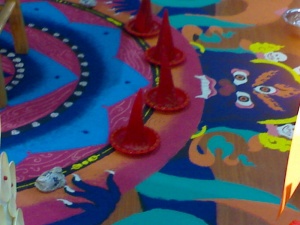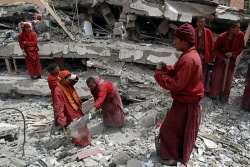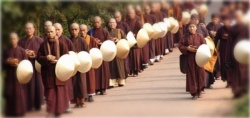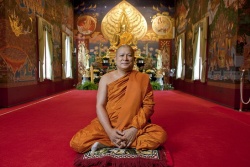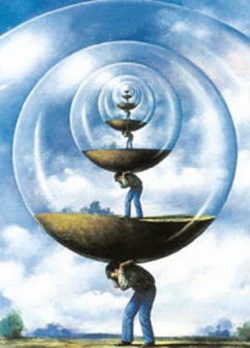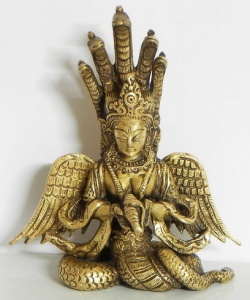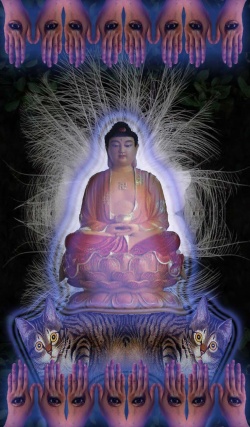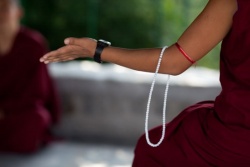Difference between revisions of "Torma"
| (11 intermediate revisions by 3 users not shown) | |||
| Line 3: | Line 3: | ||
[[File:Torma making.jpg|thumb|right|Making tormas]] | [[File:Torma making.jpg|thumb|right|Making tormas]] | ||
[[File:Bundesarchiv Bild 135-KA-07-093, Tibetexpedition, Mönch mit Butterfiguren.jpg|thumb|right|Monk making tormas in [[Sera Monastery]] in 1939]] | [[File:Bundesarchiv Bild 135-KA-07-093, Tibetexpedition, Mönch mit Butterfiguren.jpg|thumb|right|Monk making tormas in [[Sera Monastery]] in 1939]] | ||
| − | < | + | <nomobile>{{DisplayImages|2434|2135|1957|1137|1466|2644|4140|2845}}</nomobile> |
| − | |||
| − | |||
| − | |||
| − | The [[Tibetan]] term comes from the [[root]] gtor-ba which means to "cast away, break up, or scatter". This implies both a [[sense]] of [[offering]] and of [[letting go]] or [[non-attachment]]. | + | |
| + | [[Torma]] (Skt: [[Balingta]], Tib: [[Tor-ma]], [[Wylie]]: [[gtor ma]]) are figures made mostly of flour and butter used in [[tantric]] [[rituals]] or as [[offerings]] in [[Tibetan Buddhism]]. | ||
| + | |||
| + | They may be dyed in different colors, often with white or [[red]] for the main [[body]] of the [[torma]]. | ||
| + | |||
| + | They are made in specific shapes based on their {{Wiki|purpose}}, usually conical in [[form]]. | ||
| + | |||
| + | A very large, central [[shrine]] [[torma]] may be [[constructed]] for {{Wiki|festivals}}, though typically they are small and placed directly on a [[shrine]], on a plate, mounted on leather or held on a special base like a [[skull]]. | ||
| + | |||
| + | History | ||
| + | |||
| + | The [[tradition]] of using [[offering cakes]] pre-dates [[Tibetan Buddhism]], though [[traditional]] [[Indian]] [[offering cakes]] — called [[bali]] or [[balingha]] in [[Sanskrit]] — are flat instead of conical. | ||
| + | |||
| + | The [[Tibetan]] term comes from the [[root]] [[gtor-ba]] which means to "[[cast away]], [[break up]], or [[scatter]]". | ||
| + | |||
| + | This implies both a [[sense]] of [[offering]] and of [[letting go]] or [[non-attachment]]. | ||
| + | |||
Variations | Variations | ||
| − | |||
| − | [[ | + | [[Tormas]] have different uses. Some are created and placed on [[shrines]] for {{Wiki|ceremonies}} or to represent [[deities]]. |
| + | |||
| + | Others are used in feast practice and consumed by practitioners during the practice. | ||
| + | |||
| + | Others are made to appease [[spirits]], [[accumulate]] [[merit]], or remove {{Wiki|obstacles}}. | ||
| + | |||
| + | They are mostly made of {{Wiki|barley}} flour and butter, but [[traditionally]] other ingredients such as egg, milk, sugar, [[honey]], and even meat may be included depending upon the {{Wiki|purpose}} of the [[torma]]. | ||
| + | |||
| + | |||
| + | ==[[Deity Tormas]]== | ||
| + | |||
| + | |||
| + | [[Deity tormas]] ([[Wylie]]: [[rten gtor]]) are kept on the [[shrine]], and represent a particular [[tantric deity]]. | ||
| + | |||
| + | These [[tormas]] vary in complexity from a very simple cone painted white for [[peaceful]] [[deities]] like [[Tara]] and [[Avalokiteshvara]], to very complex designs for [[semi-wrathful deities]] like [[Vajrayogini]] and [[Chakrasamvara]]. | ||
| + | |||
| + | |||
| + | ==[[Food Tormas]]== | ||
| + | |||
| + | |||
| + | [[Food tormas]] ([[Wylie]]: [[skang gtor]]) are used in feast practices and are consumed partially by practitioners during the feast, with leftovers ([[Wylie]]: [[dme gtor]]) [[offered]] to lower [[beings]] after being blessed. | ||
| + | |||
| + | In some [[traditions]], [[food]] [[tormas]] are now made with more contemporary ingredients whereas others stay [[faithful]] to the {{Wiki|barley}} flour [[tradition]]. | ||
| + | |||
| + | |||
| + | ==[[Offering Tormas]]== | ||
| + | |||
| + | |||
| + | [[Offering tormas]] may be made for and [[offered]] to [[deities]] ([[Wylie]]: [[sgrub gtor]] / [[mchod gtor]]), to [[Dharma Protectors]], to obstructing [[spirits]], or to other lower [[beings]]. | ||
| + | |||
| + | [[Torma for obstructing spirits]] are called [[gektor]]. | ||
| + | |||
| + | |||
| + | ==[[Medicinal Torma]]== | ||
| + | |||
| + | |||
| + | A [[torma]] may be used in [[Tibetan medicine]] to extract an {{Wiki|illness}} from a {{Wiki|patient}} as a cure. The [[torma]] is then cast away. | ||
| + | |||
| + | |||
| + | ==[[Captured Torma]]== | ||
| + | |||
| + | |||
| + | A [[captured torma]] ([[Wylie]]: [[gta' gtor]]) may be used to {{Wiki|speed}} completion of [[activities]], by planning to offer the [[torma]] at the completion of the [[activity]] thereby encouraging successful [[activity]]. | ||
| + | |||
| + | |||
| + | ==[[Inner Torma]], [[Secret Torma]] and [[Very Secret Torma]]== | ||
| + | |||
| + | |||
| + | Practicing [[meditation]] with [[deity visualization]] is considered a [[form]] of [[torma offering]], though no [[physical]] cake is created and then [[offered]]. | ||
| + | |||
| + | Similarly, [[offering]] one's internal [[emotional]] and [[mental]] [[experiences]] and [[experience]] of [[suchness]] are [[non-physical]] [[forms]] of [[torma offerings]]. | ||
| + | |||
| + | |||
| + | [[Tormas]] (Skt.: [[bali]]) are [[offering]] cakes. | ||
| + | |||
| + | They [[symbolize]] the [[food offering]]. | ||
| + | |||
| + | Originally made of dough (in [[Tibet]], [[roasted barley flour]] is used,) and also sculpted from butter, they have evolved into elaborately decorated [[objects]]. | ||
| + | |||
| + | Since making them is time-consuming, [[people]] have begun to use clay, [[wood]] and more recently, {{Wiki|synthetic}} {{Wiki|substances}}. | ||
| − | + | These include resin modeling products, and at least one {{Wiki|Asian}} company produces small, injection-moulded plastic [[tormas]]. | |
| − | |||
| − | [[ | + | [[Symbolic offerings]] at one [[time]] (pre-[[Buddhism]], naturally,) may have been substitutes for [[living beings]]. |
| − | + | However, the [[Tibetan]] [[word]], spelled [[gtor.ma]], has an {{Wiki|etymology}} that is especially revealing. | |
| − | [[ | + | [[Lama]] [[Tashi Dondrup]] once explained that the [[word]], composed of two parts, stands for "something that is thrown out" + "mother" (a signifier that is {{Wiki|female}}.) |
| − | + | The implication is one of cutting of [[attachment]] combined with [[care]] and [[generosity]] without limitation. | |
| − | |||
| − | + | Although a [[torma]] has specific {{Wiki|characteristics}} that depend upon the [[deity]] to whom it is being [[offered]], all [[tormas]] have three fundamental [[elements]] to their construction: foundation, [[body]], and decoration. | |
| − | + | These [[symbolize]] respectively the qualities of [[body]], [[speech]], and [[mind]]. | |
| − | + | The energies of these qualities are represented by two or three small, rather flat, discs applied to the front of the conical [[body]]. | |
| − | + | Usually they are in the [[form]] of [[flowers]]; the rims can be pressed to create the scalloped effect of petals. | |
| − | + | Finally, one or more dabs of coloured butter (or nowadays, a [[margarine-wax mix]]) known as [[gyab gyen]] are sometimes pressed onto the "[[back]]" (Tib. [[gyab]]) of the [[torma]]. | |
| − | [[ | + | This [[action]] dedicates the [[offering]]: |
| − | + | . . . it [[seals]] the [[torma offering]] so that its [[essence]] won't be lost or stolen before you get a chance to offer it. I've also heard that it's a gesture, as if you were saying, "thus, I offer." ~ [[ani]] [[Yeshe Wangmo]] | |
| − | + | A [[torma]] of elaborate design may be decorative, but it is not as important as the [[action]] of [[generosity]] which it represents. | |
| − | + | The colours reflect the [[nature]] of the [[deity]] to which it is being [[offered]], and can also correspond to [[traditional]] [[yogic]] {{Wiki|principles}}. | |
| − | + | [[halzey tormas]] (Skt. [[naividya bali]]) intended for a personal [[shrine]] are usually between 4 and 6 inches high, but they can be any size. It takes a large snowball-sized ball of dough to make one that is in the small range with a three-inch {{Wiki|diameter}} base. | |
| − | + | Since the [[bala]] or [[torma]] is intended for a [[deity]], we take [[care]] to keep its ingredients [[pure]], and the surface on which we are working clean. The hands must be washed and the maker should avoid {{Wiki|breathing}} on the project. | |
| − | + | Any bits that fall to the floor are unusable and must be discarded. | |
| − | + | The ingredients to make sixteen six-inch [[tormas]] are as follows. | |
| − | + | ||
| + | A five-pound bag of flour without yeast, one cup of butter or shortening (it can be colored with [[food]] dye), and a large pot one-third full of [[water]]. | ||
| + | |||
| + | |||
| + | First, bring the [[water]] to boil. Next, add the butter. | ||
| + | |||
| + | Then add flour. Stir and let boil for three to five minutes. | ||
Mix, then let it sit to cool a little. It should be just sticky enough to be easily kneaded. | Mix, then let it sit to cool a little. It should be just sticky enough to be easily kneaded. | ||
| + | |||
The dough (which may still be [[hot]] -- be careful) is removed from the pot and placed on the clean surface where it is kneaded until it is uniformly soft and smooth. (If it sticks too much, dust your hands and/or the surface with flour.) | The dough (which may still be [[hot]] -- be careful) is removed from the pot and placed on the clean surface where it is kneaded until it is uniformly soft and smooth. (If it sticks too much, dust your hands and/or the surface with flour.) | ||
| − | |||
| − | + | If you intend to use {{Wiki|real}} [[food]] [[tormas]], they must be kept intact. | |
| + | |||
| + | If they show [[signs]] of age -- bits falling off, etc. -- then they need to be repaired or replaced. | ||
| + | |||
| + | [[Tormas]] made of [[food]] are never tossed in the garbage but are left outside in a clean place for birds and other [[animals]] to enjoy. | ||
| − | |||
| − | + | NB. If you are going to use a {{Wiki|synthetic}} [[substance]] instead of flour, include some grains of {{Wiki|rice}} or other cereal in the [[torma]] so that it still has [[integrity]] in the [[sense]] of a [[food]] [[offering]]. | |
| − | |||
| − | + | ||
| − | + | ==[[Butter Sculpture]]== | |
| + | |||
| + | |||
| + | Butter [[tormas]] are usually made by [[Buddhist]] [[monastics]] for a special occasion. | ||
| + | |||
| + | They used to be made only where [[conditions]] were cool enough for them to survive for a while without melting. | ||
| + | |||
| + | The [[monks]] had to keep dipping their hands into cold [[water]] to do the modeling. | ||
| + | |||
| + | Nowadays, the butter or margarine is mixed with candle wax before colouring is added. | ||
| + | |||
| + | They use aids such as hollow [[bones]] or straws for making long threads, and molds for making the [[chakras]] /[[flowers]] and leaves that are applied to the main [[form]]. | ||
| + | |||
| + | |||
| + | The sculpted [[forms]] are often displayed on bats [wooden boards] that have been gold-leafed. | ||
| + | |||
| + | In [[Lhasa]], for the [[Losar]] [[new year]] celebration 's [[Butter Lamp]] {{Wiki|Festival}} on the 15th of the first [[Tibetan]] month, all sorts of fantastic figures are made for display alongside the lamps that [[traditionally]] use butter as fuel. | ||
| + | |||
| + | On the 19th, at the end of the {{Wiki|festival}}, the [[torma]] and the [[zur]] are burnt in the {{Wiki|ceremony}}, thus burning the [[evil]] that has been attracted to them. | ||
| + | |||
| + | Though this is called the [[torma]] {{Wiki|festival}}, the actual [[object]] to be thrown was called the [[zur]]. | ||
| + | |||
| + | |||
| + | The [[zur]] was an eight or nine-foot high tripod of sticks . . . decorated with [[butter sculptures]] of flames, clouds, [[gems]] and other [[symbols]]. On the top was a big [[skull]] from which flames are issued. | ||
| + | |||
| + | Many ribbons or strings are tied to the top of the tripod. | ||
| + | |||
| + | Inside the {{Wiki|legs}} of the tripod was a [[torma]], and depending on the {{Wiki|purpose}}, its size and {{Wiki|color}} varied. | ||
| + | |||
{{W}} | {{W}} | ||
| − | |||
[[Category:Buddhist Terms]] | [[Category:Buddhist Terms]] | ||
| + | [[Category:Torma]] | ||
| + | [[Category:Rituals]] | ||
[[Category:Offerings]] | [[Category:Offerings]] | ||
| − | |||
{{TibetanTerminology}} | {{TibetanTerminology}} | ||
Latest revision as of 16:47, 1 April 2023

Torma (Skt: Balingta, Tib: Tor-ma, Wylie: gtor ma) are figures made mostly of flour and butter used in tantric rituals or as offerings in Tibetan Buddhism.
They may be dyed in different colors, often with white or red for the main body of the torma.
They are made in specific shapes based on their purpose, usually conical in form.
A very large, central shrine torma may be constructed for festivals, though typically they are small and placed directly on a shrine, on a plate, mounted on leather or held on a special base like a skull.
History
The tradition of using offering cakes pre-dates Tibetan Buddhism, though traditional Indian offering cakes — called bali or balingha in Sanskrit — are flat instead of conical.
The Tibetan term comes from the root gtor-ba which means to "cast away, break up, or scatter".
This implies both a sense of offering and of letting go or non-attachment.
Variations
Tormas have different uses. Some are created and placed on shrines for ceremonies or to represent deities.
Others are used in feast practice and consumed by practitioners during the practice.
Others are made to appease spirits, accumulate merit, or remove obstacles.
They are mostly made of barley flour and butter, but traditionally other ingredients such as egg, milk, sugar, honey, and even meat may be included depending upon the purpose of the torma.
Deity Tormas
Deity tormas (Wylie: rten gtor) are kept on the shrine, and represent a particular tantric deity.
These tormas vary in complexity from a very simple cone painted white for peaceful deities like Tara and Avalokiteshvara, to very complex designs for semi-wrathful deities like Vajrayogini and Chakrasamvara.
Food Tormas
Food tormas (Wylie: skang gtor) are used in feast practices and are consumed partially by practitioners during the feast, with leftovers (Wylie: dme gtor) offered to lower beings after being blessed.
In some traditions, food tormas are now made with more contemporary ingredients whereas others stay faithful to the barley flour tradition.
Offering Tormas
Offering tormas may be made for and offered to deities (Wylie: sgrub gtor / mchod gtor), to Dharma Protectors, to obstructing spirits, or to other lower beings.
Torma for obstructing spirits are called gektor.
Medicinal Torma
A torma may be used in Tibetan medicine to extract an illness from a patient as a cure. The torma is then cast away.
Captured Torma
A captured torma (Wylie: gta' gtor) may be used to speed completion of activities, by planning to offer the torma at the completion of the activity thereby encouraging successful activity.
Inner Torma, Secret Torma and Very Secret Torma
Practicing meditation with deity visualization is considered a form of torma offering, though no physical cake is created and then offered.
Similarly, offering one's internal emotional and mental experiences and experience of suchness are non-physical forms of torma offerings.
Tormas (Skt.: bali) are offering cakes.
They symbolize the food offering.
Originally made of dough (in Tibet, roasted barley flour is used,) and also sculpted from butter, they have evolved into elaborately decorated objects.
Since making them is time-consuming, people have begun to use clay, wood and more recently, synthetic substances.
These include resin modeling products, and at least one Asian company produces small, injection-moulded plastic tormas.
Symbolic offerings at one time (pre-Buddhism, naturally,) may have been substitutes for living beings.
However, the Tibetan word, spelled gtor.ma, has an etymology that is especially revealing.
Lama Tashi Dondrup once explained that the word, composed of two parts, stands for "something that is thrown out" + "mother" (a signifier that is female.)
The implication is one of cutting of attachment combined with care and generosity without limitation.
Although a torma has specific characteristics that depend upon the deity to whom it is being offered, all tormas have three fundamental elements to their construction: foundation, body, and decoration.
These symbolize respectively the qualities of body, speech, and mind.
The energies of these qualities are represented by two or three small, rather flat, discs applied to the front of the conical body.
Usually they are in the form of flowers; the rims can be pressed to create the scalloped effect of petals.
Finally, one or more dabs of coloured butter (or nowadays, a margarine-wax mix) known as gyab gyen are sometimes pressed onto the "back" (Tib. gyab) of the torma.
This action dedicates the offering:
. . . it seals the torma offering so that its essence won't be lost or stolen before you get a chance to offer it. I've also heard that it's a gesture, as if you were saying, "thus, I offer." ~ ani Yeshe Wangmo
A torma of elaborate design may be decorative, but it is not as important as the action of generosity which it represents.
The colours reflect the nature of the deity to which it is being offered, and can also correspond to traditional yogic principles.
halzey tormas (Skt. naividya bali) intended for a personal shrine are usually between 4 and 6 inches high, but they can be any size. It takes a large snowball-sized ball of dough to make one that is in the small range with a three-inch diameter base.
Since the bala or torma is intended for a deity, we take care to keep its ingredients pure, and the surface on which we are working clean. The hands must be washed and the maker should avoid breathing on the project.
Any bits that fall to the floor are unusable and must be discarded.
The ingredients to make sixteen six-inch tormas are as follows.
A five-pound bag of flour without yeast, one cup of butter or shortening (it can be colored with food dye), and a large pot one-third full of water.
First, bring the water to boil. Next, add the butter.
Then add flour. Stir and let boil for three to five minutes.
Mix, then let it sit to cool a little. It should be just sticky enough to be easily kneaded.
The dough (which may still be hot -- be careful) is removed from the pot and placed on the clean surface where it is kneaded until it is uniformly soft and smooth. (If it sticks too much, dust your hands and/or the surface with flour.)
If you intend to use real food tormas, they must be kept intact.
If they show signs of age -- bits falling off, etc. -- then they need to be repaired or replaced.
Tormas made of food are never tossed in the garbage but are left outside in a clean place for birds and other animals to enjoy.
NB. If you are going to use a synthetic substance instead of flour, include some grains of rice or other cereal in the torma so that it still has integrity in the sense of a food offering.
Butter Sculpture
Butter tormas are usually made by Buddhist monastics for a special occasion.
They used to be made only where conditions were cool enough for them to survive for a while without melting.
The monks had to keep dipping their hands into cold water to do the modeling.
Nowadays, the butter or margarine is mixed with candle wax before colouring is added.
They use aids such as hollow bones or straws for making long threads, and molds for making the chakras /flowers and leaves that are applied to the main form.
The sculpted forms are often displayed on bats [wooden boards] that have been gold-leafed.
In Lhasa, for the Losar new year celebration 's Butter Lamp Festival on the 15th of the first Tibetan month, all sorts of fantastic figures are made for display alongside the lamps that traditionally use butter as fuel.
On the 19th, at the end of the festival, the torma and the zur are burnt in the ceremony, thus burning the evil that has been attracted to them.
Though this is called the torma festival, the actual object to be thrown was called the zur.
The zur was an eight or nine-foot high tripod of sticks . . . decorated with butter sculptures of flames, clouds, gems and other symbols. On the top was a big skull from which flames are issued.
Many ribbons or strings are tied to the top of the tripod.
Inside the legs of the tripod was a torma, and depending on the purpose, its size and color varied.
